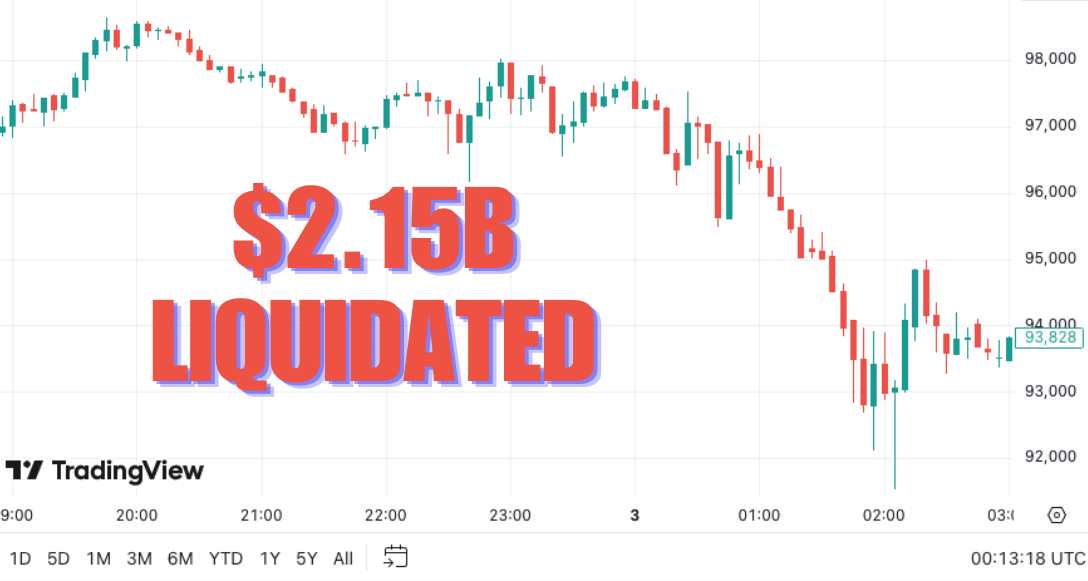In the fast-paced world of digital assets, even a single weekend can rewrite the market’s story. Recent events have demonstrated this yet again as over 2.15 billion dollars vanished from the crypto market in a matter of hours. From massive liquidations to sudden price dips—this is the story of the latest crypto shakeout, why it happened, and how investors can protect themselves.
Billions Lost, Markets Rattled
2.15 billion dollars in liquidations occurred across long and short positions, triggered by abrupt drops in major cryptocurrencies. Of that total, 1.83 billion were long positions—traders betting on the market going up—while short positions accounted for 324 million.
What caused this cascade? The primary culprit was over-leverage. As Bitcoin slipped below its critical support (around $97,000 down to $92,000), automated margin calls and forced liquidations created a domino effect. When prices drop too far, trading platforms liquidate positions to repay borrowed funds. One liquidation triggers lower prices, causing further forced sell-offs in a vicious cycle known as a liquidation cascade.
Comparing the Carnage
Though Bitcoin’s dip was only about 5–10%—not catastrophic by crypto standards—it unleashed more liquidations than the infamous Luna (1.2 billion dollars) and FTX (1.6 billion dollars) crashes. Some key takeaways:
- Ethereum traders lost over $609 million in short order.
- Altcoins like Dogecoin and Solana were hit even harder, showcasing how smaller-cap tokens typically suffer more violently when the market dips.
- XRP plunged by 43%, reaching lows last seen in early 2024. Yet it rebounded soon after, offering a 50% gain for anyone who bought at the bottom.
Such swift declines followed by similarly rapid recoveries highlight the extreme volatility inherent to digital assets—one minute the markets appear to be in freefall, and the next, a bounce can reward the bold.
Bear Trap or Prelude to a Bull Run?
Sharp corrections sometimes precede significant rallies. Historically, crypto markets go through boom-and-bust cycles, with each dip shaking out “weak hands” before a stronger upswing. Current data shows:
- Bitcoin rebounded above $100,000 soon after its tumble but remains volatile.
- Altcoins are beginning to recover, suggesting a possible bullish continuation if major support levels hold.
- If Bitcoin fails to maintain a crucial support above $92,000, the next leg down could target $83,000, dragging most altcoins with it.
Guarding Against Liquidation Cascades
As volatility continues, protecting yourself and your portfolio becomes more important than ever. AI-powered tools can help traders navigate these turbulent waters:
- Automated Strategies
Platforms like Arrow Algo empower users to build trading strategies without extensive coding knowledge. By setting stop-losses, take-profit targets, and rules-based systems, traders reduce emotional decision-making. - Scenario Testing
Before deploying any strategy, backtesting on historical data can expose weaknesses. AI chat interfaces even allow you to request new scenarios—like “a strategy that performs well in a bull run but safeguards against bear traps”—and refine them until you’re satisfied. - 24/7 Monitoring
Crypto markets never sleep, but AI can watch the charts for you. Automated bots follow predefined rules and adjust positions instantly as conditions change, minimizing the risk of being caught off-guard.
Final Thoughts: Pain Before Glory?
While nobody has a crystal ball, the dramatic swings over the last few days aren’t unprecedented. Crypto markets are known for their resilience and capacity to rebound strongly after steep pullbacks. It’s an environment rich with potential for gains—if approached with prudent risk management.
For many, these market moments serve as a reminder:
- Use sensible leverage (if any).
- Diversify assets.
- Maintain disciplined stop-losses.
- Consider AI-driven strategies that mitigate human error.
Crypto thrives on volatility, and that volatility can either break portfolios or propel them sky-high. Armed with intelligent trading tools and a solid understanding of market cycles, investors are better positioned to ride the waves—instead of getting washed away by them.

Did you enjoy this? You may like:


Leave a Reply